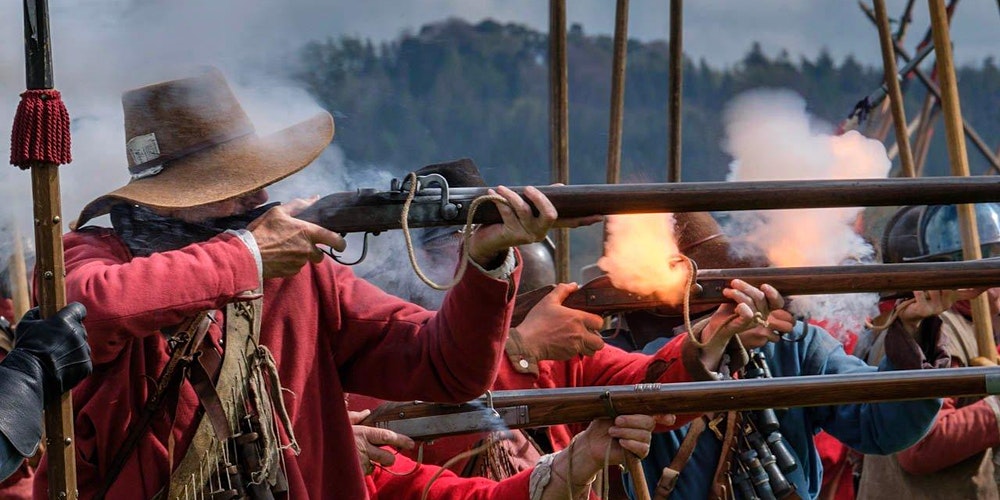
17th Century Almanac for October
The 17th Century almanac for October, when ‘nature now spreads around, in dreary hue, a pall to cover all that summer knew.’
It is the end of the campaign season, and I am back at my desk writing book #3. However, I thought it was also a good time to start a new blog post. I want to share my research on farming in Early Modern Britain and the 17th Century almanac.
17th Century Life & The Little Ice Age
I felt I needed to better understand this fundamental aspect of pre-industrial life. The farming year affected everyone. It was the backdrop to every campaign of the British Civil Wars. I based much of this research on the rhyming almanacs of Thomas Tusser, particularly his ‘Five Hundred Points of Husbandry’. This was published in 1580. However, I don’t think much had changed in the way we farmed by 1640.
What did change was the increasing social upheaval of acts of enclosure. These were coupled with the devastating impact of the Little Ice Age. Both are now acknowledged as significant causes of conflict leading to the English Civil War and the British Civil Wars in general – the most violent period of conflict in British history.
Michaelmas
September the 29th was and is Michaelmas. It was an English quarter day, the start and end of the farming year. New contracts and leases were let, yearly rents, dues and tithes paid. Gleaning of the fields for fallen grain – by women, children and the poor – was ended. Fresh herring and fattened crones were eaten, and St Michael the Archangel was venerated. This seems like a good time to start this blog post.
Medieval Open Fields
For those interested in the 17th Century year, Tusser tells us that October was the month when those fields that had been left fallow, to recover over the summer, were ploughed for a third and final time. They were sowed with wheat or rye and the precious grain harrowed in. This was the key ‘cash’ crop. These fields were guarded over the next weeks by women and boys. They used slings and bows against pigeons, rooks and crows. When the last of the wheat was sown, all celebrated with seed cake, pasties and frumentary pot.
In the other fields, the last of the wheat stubble was gathered in. However, the bean fields were left as fallow for the next year’s wheat. This allowed the soil to fix in the beans’ much needed natural nitrogen. Grazing on the commons ended on the 8th and on the wheat stubble on 15 October. On this date, ewes were put to ram. This is still the way in the Nottinghamshire village of Laxton, the last ‘champion’ or open field village in England.
The Hunter’s Moon & Biodynamics
In the 17th Century, farming and fishing were driven by the seasons, the weather and by the moon. We easily forget how important the state of the moon was to planting and reaping, as well as to the tides. As Thomas Tusser tells us, we should harvest after a full moon and sow on a waxing new moon.
‘Cut all thing or gather, the Moon in the wane, But sow in increasing, or give it his bane.’
This idea may seem to be merely superstition. However, it is making a resurgence amongst top winemakers and vineyards as biodynamics.
For those that take an interest in such things, the Hunter’s Moon will rise on the 14th. It will be full on 28 October. As ever, migrating ducks will arrive with the full moon. ‘Falls’ of woodcock will also arrive. The latter were thought to arrive each year from the moon, falling to earth in October.
All Hallows Eve, Halloween & Samhain
The end of the month will see All Hallows Eve, Halloween or Samhain. This was once a time when the dead were remembered with church candles and burning tindles in the fields. November the 1st was and is All Saints’ Day. This was a cross-quarter day in England. According to Tusser, the day was celebrated with pork and souse, sprats and sparlings.
Whether you are ploughing and sowing next year’s wheat, waiting for the woodcock to fall or settling in for the winter, enjoy the autumn hues.
Follow & Read More
I will post more of the 17th Century almanac and yearly activity in Early Modern Britain, next month, in November. If you would like to receive an email notification of the next post, click the button to follow.
In the meantime, this website includes more posts and articles about life in 17th Century Britain, Europe and the Americas at Historical Notes and Maps. These include notes and pages on the impact of the Little Ice Age and The General Crisis of the 17th Century. They include articles on the English Revolution and Great Rebellion. They also include Pike and Shot Warfare and battles of the English Civil War.
You can also find more posts on Early Modern history, Living History and re-enactment at News & Events. You may also wish to read about the English Civil War history talks and battlefield walks I give.
See More & Share
Alternatively, check out Facebook, Instagram, Twitter or YouTube for more posts. These include notes from my historical research, Living History and English Civil War fiction. They also include upcoming events and opportunities to meet. Or, follow on social media at #DividedKingdomBooks or #EnglishCivilWarFiction on:
If you want even more, join us in the Divided Kingdom Readers’ Club. You will receive FREE access to exclusive short stories, email and more. Click the link to sign up and join the Clubmen.
Spread the Word
If you like what you see, please click, share and spread the word via email or your social media on:



